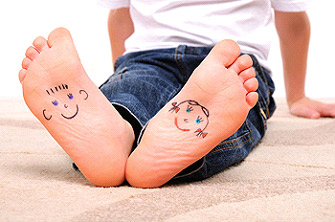
It is never normal for a child to experience pain in his or her feet. Foot pain that lasts more than a few days and limits a child’s ability to walk should be examined by a podiatrist. Many adult foot ailments originate in childhood and may be present at birth. Common foot issues that are experienced by children are pediatric flat foot, Sever’s disease, ingrown toenails, and plantar warts.
A child’s foot grows rapidly during the first year. Consequently, foot specialists consider the first year to be the most crucial point in the foot development process. There are ways you can help ensure that your child’s feet develop properly. One way is to carefully look at your baby’s feet. If you notice any deformities, you should immediately seek professional care. You should also loosely cover your child’s foot, since tight coverings may prevent movement and inhibit normal development. Another tip is to change the baby’s positioning throughout the day. If your baby lies down in one spot for too long, it may put an excessive amount of strain on the feet and legs.
It is best that you try not to force a child to start walking. Children will begin to walk when they are both physically and emotionally capable to do so. You should also avoid comparing your child’s walking progress with other children because the age range for independent walking varies. When your child’s feet begin to develop, you may need to change both their shoe and sock size every few months to allow room for their feet to grow.
Kids are sometimes prone to splinters, cuts, and severe injuries because they tend to walk around barefoot. This also makes them more susceptible to developing plantar warts, a condition caused by a virus that invades the sole of the foot through breaks in the skin. These ailments can be avoided by making sure your child wears shoes in unsanitary environments. You should also wash any minor cuts or scrapes on your child’s feet.
Kids are also prone to developing Sever’s disease, which is the inflammation of the growth plate in the heel. Typically the result of overuse, Sever’s disease often develops inactive children who are experiencing a growth spurt. When a child experiences a growth spurt, the heel bone will often grow faster than the other muscles, tendons, and ligaments in his or her lower extremities. This causes Sever’s disease.
As a parent, you should ensure that your child’s feet are developing properly and are being properly maintained. Consequently, it is important that you perform routine inspections on his or her feet to detect any injuries or deformities in their early stages. Early detection and treatment will help to ensure that your child does not develop any serious foot conditions.
Children with strong, healthy feet avoid many kinds of lower extremity problems later in life. That’s why it is important to inspect your children’s feet periodically.
Infants
The size and shape of your baby’s feet change quickly during their first year. Because a baby’s feet are flexible, too much pressure or strain can affect the shape of their feet. It’s important to allow baby to kick and stretch their feet freely. Also, make sure shoes and socks do not squeeze the toes.
Toddlers
Do not to force a toddler to walk before s/he is ready. Once walking begins, watch the toddler’s gait. Many toddlers have a pigeon-toe gait, which is normal. Some initially learn to walk landing on their toes instead of their heels. Most children outgrow both these problems. But other conditions detected early can be treated more easily.
When Foot Care Is Needed
To help with flatfeet, special shoes or orthotics may be prescribed. To correct mild in-toeing or out-toeing, your toddler may need to sit in a different position while playing or watching TV. If your child’s feet turn in or out a lot, corrective shoes, splints, or night braces may be prescribed.
The foot’s bone structure is well-formed by the time your child reaches age 7 or 8, but if a growth plate (the area where bone growth begins) is injured, the damaged plate may cause the bone to grow oddly. With a doctor’s care, however, the risk of future bone problems is reduced.
Remember to check your child’s shoe size often. Make sure there is space between the toes and the end of the shoe and that the shoes are roomy enough to allow the toes to move freely. Don’t let your child wear hand-me-down shoes.
